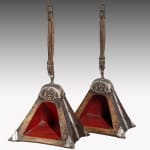Pair of 19th Century Carved Wood and White Metal Mounted Stirrups
PERU, CIRCA 1850
18 1/2 x 10 5/8 x 8 1/8 in
47 x 27 x 20.5 cm
47 x 27 x 20.5 cm
6832
Further images
The intricately carved wooden stirrups with white metal, floral decorated mounts, red painted interiors and woven textile straps with metal buckles. The chalan or morochuco in Peru are similar to...
The intricately carved wooden stirrups with white metal, floral decorated mounts, red painted interiors and woven textile straps with metal buckles.
The chalan or morochuco in Peru are similar to the Guachos of Argentina and the Llaneros of Venezuela. Their stirrups are distinct from those of the Argentinian Gauchos who often rode barefoot with simple round wooden stirrups.
A similar pair of stirrups are in the collection of the Brooklyn Museum, accession no. 41.1275.235b (Museum Expedition 1941, Frank L. Babbott Fund). This pair is included in 'Converging cultures: art & identity in Spanish America' by Diana Fane, Brooklyn Museum; Phoenix Art Museum; Los Angeles County Museum of Art, 1996 (p. 269-70). The entry states that the stirrups are late 18th or early 19th century and references J.J. von Tschudi, saying he 'offers perhaps the richest account of Peruvian horses and horsemanship based on his travels between 1838 and 1842.'' Tschudi wrote 'They are made of carved wood and are of pyramidal shape: about a foot high and a foot broad at the base. In front and at the sides they are close[d], and are open only at the back in the part where the foot rests. The edges are rimmed with silver, and the top of the stirrup is surmounted by a bell of the same metal, with a ring through which the straps are passed.' (J.J. von Tschudi, Travels in Peru during the years 1838-1842 (New York, 1853).
The chalan or morochuco in Peru are similar to the Guachos of Argentina and the Llaneros of Venezuela. Their stirrups are distinct from those of the Argentinian Gauchos who often rode barefoot with simple round wooden stirrups.
A similar pair of stirrups are in the collection of the Brooklyn Museum, accession no. 41.1275.235b (Museum Expedition 1941, Frank L. Babbott Fund). This pair is included in 'Converging cultures: art & identity in Spanish America' by Diana Fane, Brooklyn Museum; Phoenix Art Museum; Los Angeles County Museum of Art, 1996 (p. 269-70). The entry states that the stirrups are late 18th or early 19th century and references J.J. von Tschudi, saying he 'offers perhaps the richest account of Peruvian horses and horsemanship based on his travels between 1838 and 1842.'' Tschudi wrote 'They are made of carved wood and are of pyramidal shape: about a foot high and a foot broad at the base. In front and at the sides they are close[d], and are open only at the back in the part where the foot rests. The edges are rimmed with silver, and the top of the stirrup is surmounted by a bell of the same metal, with a ring through which the straps are passed.' (J.J. von Tschudi, Travels in Peru during the years 1838-1842 (New York, 1853).








